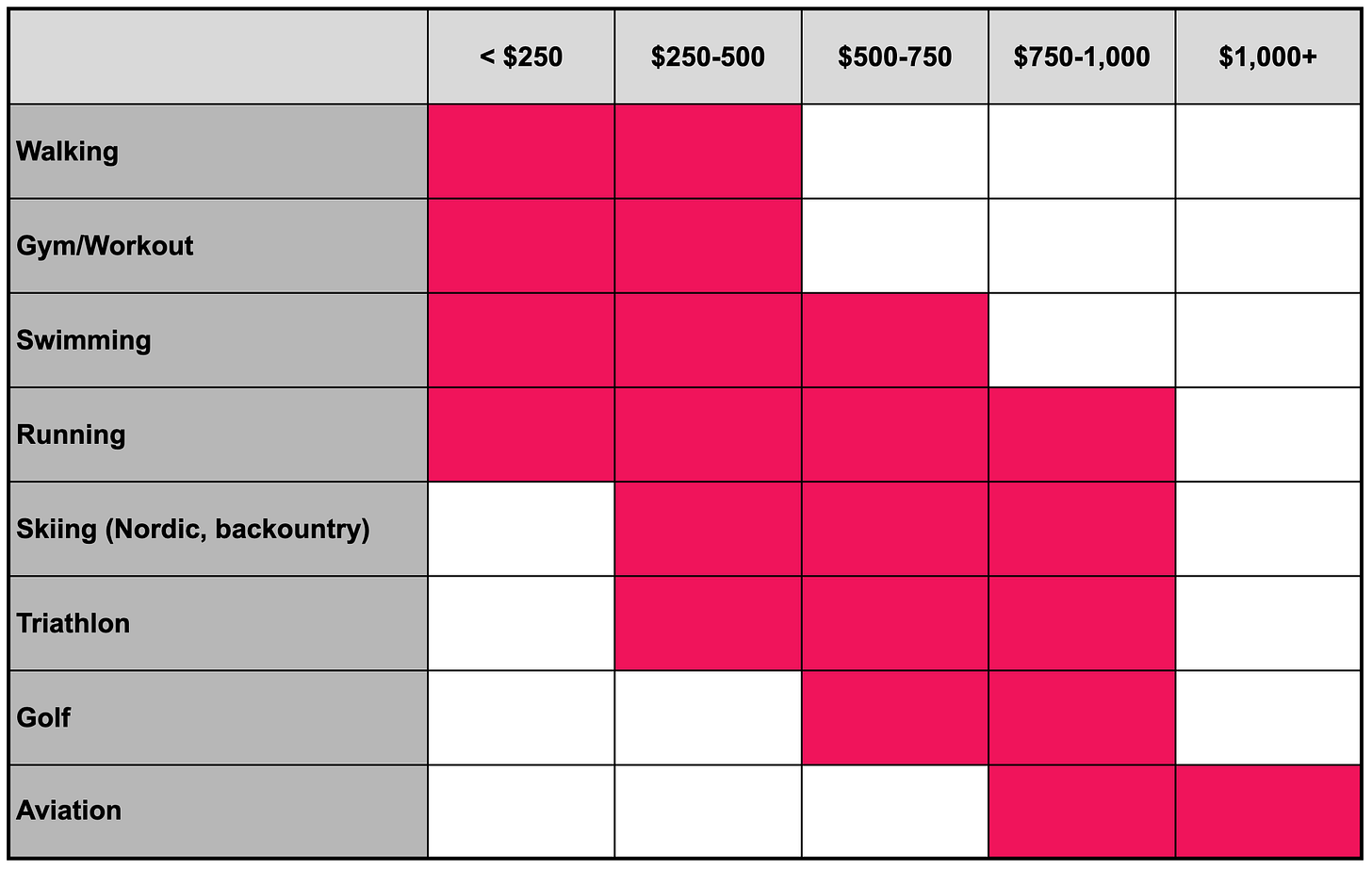Getting Lost Trying to Find a GPS Watch
What the GPS watch market tells us about the broader outdoor gear market
This past weekend, my partner and I went trail running up in the White Mountains in New Hampshire, and by halfway through the 4-hour run, my aging Apple Watch Series 6 had drained down to about 40% battery from a full charge. It was almost full panic stations— always remember that a workout doesn’t count unless the whole thing gets posted on Strava! I had already started to passively search for a new GPS/smart/fitness watch (collectively “GPS watch” for this article), and planned to write this article about the pricing of GPS watches, and it turns out that coinciding a market survey and review article with my personal watch hunt was proving to be even better timing-wise than I anticipated!
Smash cut to me on Tuesday night, though, opening up the Garmin website to catalog their watches to see a total of over 80(!) watches on display. I was temporarily filled with regret about taking on the task, confused why Garmin sold many types of GPS watches, and overwhelmed to possibly have to select one from the bunch to purchase. I ended up channeling these “dire” emotions into a (relatively) productive data capture session that I think yielded some interesting insights about the GPS watch market.

I was interested in the GPS watch market before diving into this research on price distribution of the products within it. The whole market is at the intersection of technology and sports (my interest sweet spot), and it contains products that serve a huge variety of customers, from mall-walkers to backcountry skiers to recreational pilots. The market contains a combination of small, focused companies like Suunto, and tech giants like Apple and Google, all while the actual GPS watches themselves are relatively simple, and differentiated predominantly by three things: their sensor suite, battery life, and user interface.
It’s a fascinating market, and my focus on the distribution of the price of its products ended up yielding a lot more insights than I expected. If nothing else, I hope the data visualizations in this article spark your own thoughts and opinions about the market.
For the actual survey (in order to protect my own sanity) I limited myself to a qualitative Top-10 of GPS watch brands, based loosely on my own knowledge of the market and their prevalence on workout tech guru DC Rainmaker’s site. If you need a guide to wearables and workout-tracking tech, you should start with his website— and so did I. Is it a comprehensive list of GPS watch manufacturers? By no means, but I think it does a good job of capturing the US market’s major offering types from budget picks to ultra-high-end products with most of the key players captured.
The following criteria helped to govern the actual list of watches that I captured prices for:
The watch needs to provide some form of activity tracking
Product needs to be listed/sold on the OEM’s website
Prices are pulled from the listing on the site, including sale prices
Does not include any listings that didn’t have a price (not sure why these are still listed, @Garmin)
Does not include any refurbished or 2nd-hand products
“Special editions” are tallied if the model included unique features, not just a unique color way
Different watch case materials and sizes are listed as individual offerings because of their impact on price
Factors that do not warrant a separate listing in the price survey:
LTE/non-LTE models (somewhat arbitrary, I must admit)
Watch color
Bracelet options
Bundles including accessories (e.g. heart rate strap)
Subscription-only products including WHOOP and Aura ring are excluded
I ended up cataloging all the individual offerings from the websites of the following companies (number of product offerings in parentheses):
Amazfit (21)
Apple (8)
Coros (4)
Fitbit (5)
Garmin (80)
Google (2)
Mobvoi (6)
Polar (11)
Samsung (11)
Suunto (8)
When you bucket all of the GPS watches from these companies by price, you end up with the following distribution:

The first thing that struck me when looking at this is the three “peaks” of the number of total product options on the market. I expected to see something more similar to a traditional Rayleigh distribution where the number of offerings tails off at higher prices without increasing beyond a certain point. However, these peaks correspond with what appears to be a sweet spot for activity-specific customers, who seemingly can afford the higher price tags.
Around $300, you start to see the most high-quality offerings that are adequate specifically for casual athletes focused predominantly on walking running, gym workouts, and recreational triathlon use. At the peak between $600-700, you find more features specific to three groups: triathletes, golfers, and ultra-runners/outdoor enthusiasts. Once you reach another small peak around $1,300, the market is almost exclusively focused on adding features for aviation, and Garmin really seems to have a chokehold on this segment of customers (more on this later).
In retrospect, I would imagine that most product offerings for most tech markets broadly follow this type of curve, where specific types of users peak the the amount of market offerings in specific price ranges— artists or audio engineers using high-end tablets jumps to mind as an example. The fact that there are fewer offerings at the higher-priced peaks is not surprising if the quantity of offerings is proportional to the total units sold. In this case, there certainly more recreational runners/athletes than triathletes/golfers/ultra-runners, and even fewer pilots making GPS watch purchases.
The overall price range shocked me on both ends of the spectrum, with there being a lot more budget options than I expected, and a fair amount of watches available with a high price tag. From a consumer mindset perspective, it’s pretty wild to think about spending more on a GPS watch than something like a brand new iPad or smart phone. From a practical perspective, it also makes me curious about why GPS watches with a set of features for a sport like triathlon or long enough battery life to last through a 100-mile race cost so much. It’s totally possible that the sensor R&D and software support are expensive enough that it yields higher prices. It’s also easy to see how you could market watches at the prices we see today when thinking about the budgets of an enthusiast triathlete, golfer, or pilot.
Someday I’d love to do a tear-down and bottoms-up cost estimate for a series of GPS watches— if anyone has any laying around, let me know!
Something else that struck me is the total number of options available on the market— around 150 in total from what I surveyed— which is a lot products to have to peruse if you want to make an informed decision. To me, what’s even more outrageous is that Garmin markets and sells over half of these, with 80 total offerings on their site. As you can see in the chart below, they skew on the more expensive end of the market, and are really the only ones marketing specifically to recreational aviators and golfers. Given they make half of the watches available, Garmin has an outsized impact on the overall market distribution, but you can still see the “peak” for watch offerings from other brands aimed at triathletes and ultra-runners around $650.

I would love to chat with Garmin some day about the thought process behind their GPS watch lineup, but in the mean time, I wanted to highlight a couple things I find egregious about their product offerings.
First, they have way too many individual watch types for sale. If I were thinking about launching my own lineup of GPS watches, I’d start with a matrix of potential users based on their activity and their budget range. A quick rough cut of what this could look like is below, but this feels like a decent starting place for such an exercise.

It’s totally possible I am missing some other use-cases and may need more granularity on price scheme, but even if you made an individual watch for each archetype of customer above, you only end up with 21 products. If you wanted a small and a large version of each watch, then you end up at 42 products total before you start to think about consolidating offerings for user groups. Somehow, Garmin has ended up with 80 GPS watch offerings, which implies that they are targeting at least 80 specific customer segments and also expect their users to actually locate all their products and understand the differences between them to purchase a specific one.
Couple this with one of the more confusing product-naming schemes that I encountered in the market, and you end up with an overwhelming shopping experience for a new customer. I think the most striking example is the Forerunner lineup of watches, which are actually quite popular and well-reviewed in recent iterations. There are currently 14 different Forerunner watches for sale, and if I had to pick between the 965, the 955, the 765, the 255 Music, the 265S, or the 165, I wouldn’t really know how choose without spending a couple hours digging into the details. I think it’s fair to rebut that point by saying that most products are named vaguely, but I think in a market like GPS watches where the differences in product offerings are small, it’s likely fruitful to be more clear about the focus of a product, even its name.

At the end of the day Garmin seems to be extremely successful in this market, so maybe the shotgun approach to product offering is effective, which would be a disappointing but unsurprising end result of my analysis/diatribe.
To take a step back to look at the whole market, though, it doesn’t seem as crowded as I expected. The 10 major players highlighted here have a fairly diverse set of offerings and a few have specific areas of focus (e.g. battery life for Coros, phone integration for Apple), but I do think there is juice to squeeze when it comes to user interfaces, activity-specific features, and product cost. WHOOP and Aura are bringing financial innovation to the industry with SaaS models, but the door is probably still open for other up-starts to break in and make a dent in the overall market with a strong beachhead offering.
In any case, if you want to see the underlying price data, have any old GPS watches you want me to take apart, or need assistance in vetting and purchasing a new GPS watch in this chaotic market, feel free to reach out! I have the link to DC Rainmaker available for reply on a moment’s notice.




